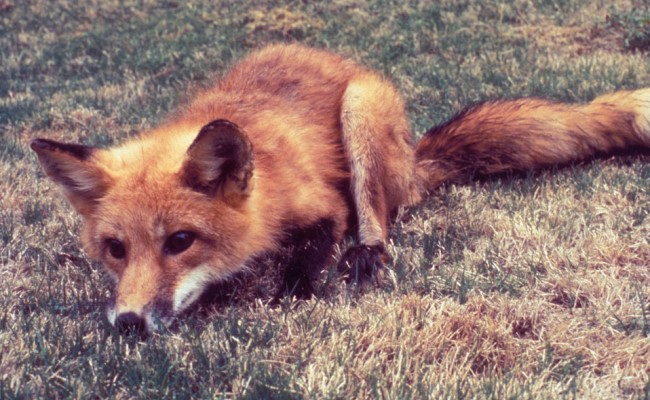Adventure
Highly Pathogenic Bird Flu Jumps Species to Wild Mammals
Over the last few months, a virus called HPAI has been killing wild birds. It is now killing mammals.
The Michigan Department of Natural Resources recently confirmed that three red fox kits died from highly pathogenic avian influenza – the state’s first such confirmation of the HPAI virus in wild mammals. The fox kits, collected between April 1 and April 14, came from three separate dens.
Highly pathogenic avian influenza is a virus known to affect birds throughout North America, with detections in backyard flocks and commercial poultry facilities, to date, in 34 states and detections in wild birds in 35 states. HPAI is highly contagious and poultry are especially vulnerable. In addition, this viral strain also affects waterfowl, raptors and scavengers (like turkey vultures, eagles and crows).
The DNR had received a report from a wildlife rehabilitator in southeastern Michigan about the fox kits exhibiting neurologic signs of HPAI before death. The kits were observed circling, tremoring and seizing. Two of the three died within hours of intake, while one appeared to respond to supportive therapy but then died in care. Interestingly, an additional kit that was a sibling of the Macomb County kit did survive, but developed blindness, making her non-releasable. This kit will be housed at a local nature center.
The three fox kits were sampled for HPAI at the DNR Wildlife Disease Lab and submitted to the Michigan State University Veterinary Diagnostic Laboratory for testing. All three kits tested “non-negative” (presumptive positive) on May 6 and were confirmed positive by the National Veterinary Services Lab in Ames, Iowa, on May 11. The virus was detected in swabs collected from the nose, mouth, throat and brain tissue of all three kits, and a full postmortem examination was conducted to aid in learning more about this disease in foxes.
It’s not panic time. But let’s be smart, hey?
Highly pathogenic avian influenza primarily affects birds, but it is important to remember that it can be a zoonotic disease (one that has the potential to be transmitted from domestic or wild animals to humans). Yes, like COVID-19. According to the U.S. Centers for Disease Control and Prevention, the public health risk associated with HPAI remains low, but advises people to avoid handling any sick or dead wild birds.
HPAI in red foxes outside Michigan
These cases in Michigan are not the first confirmed detections of HPAI in red foxes:
- A recent article in Emerging Infectious Diseases demonstrated H5N1 virus detection in wild red fox kits at a rehabilitation center in the Netherlands in May 2021, during an outbreak of HPAI in wild birds.
- In North America, the first report of HPAI H5N1 in wild mammals occurred in Canada May 2, 2022, when two wild fox kits in Ontario tested positive for the virus. One of the kits was found dead and the other displayed severe neurologic signs before dying at a rehabilitation center. Virus was detected in brain tissue, and sequencing results indicate that it is the same strain of HPAI found in the current North American outbreak (H5N1 A/goose/Guangdong/1996 (Gs/GD) lineage).
- The Minnesota Department of Natural Resources on Wednesday reported that state’s first confirmed case of HPAI in a wild mammal, a wild fox kit from Anoka County.
“HPAI H5N1 viruses may occasionally transmit from birds to mammals, as occurred in these cases, and there may be additional detections in other mammals during this outbreak, but they likely will be isolated cases,” said Megan Moriarty, state wildlife veterinarian with the Michigan DNR. “At this point, it is unclear how the fox kits became infected, but it’s possible that they were exposed by consuming infected birds, such as waterfowl.”
Reporting sick or dead wildlife
Anyone who notices what appears to be unusual or unexplained deaths among wild birds or sick, dead or neurologically abnormal foxes is asked to report the information by contacting their local DNR. Moriarty encouraged the public to continue sharing such wildlife observations, even though the DNR will be unable to respond to every person submitting a report.
“We greatly appreciate the effort to report instances of animals that are sick or appear to have unusual or unexplained deaths, because those tips often lead to important information,” said Moriarty. “Every bird or animal reported may not be tested for HPAI, but all observations are important.”
HPAI in domestic flocks
Highly pathogenic avian influenza is highly contagious and can be spread to domestic flocks by wild birds, through contact with infected poultry, by equipment, and on the clothing and shoes of caretakers. Make sure domestic poultry (e.g., chickens, turkeys, geese and ducks raised for the production of meat or eggs) is separate from and has no contact with wild birds.
The Michigan Department of Agriculture and Rural Development stated that no birds or bird products infected with HPAI will enter the food chain. As a reminder, all poultry and eggs should be handled and cooked properly, with a safe cooking temperature of 165 degrees Fahrenheit.
Domestic bird owners and caretakers should watch for unusual deaths, a drop in egg production, a significant decrease in water consumption or an increase in sick birds.
-

 Hiking & Climbing1 week ago
Hiking & Climbing1 week agoWhen Bears Bring the Drama: A Tail—or Should I Say “Tale”?
-

 Adventure1 month ago
Adventure1 month agoREACTION: Trump’s Make America Beautiful Again Agenda
-

 Gear2 months ago
Gear2 months agoLet Freedom RING! Primary Arms’ Independence Day Category Sale Starts NOW
-

 Adventure2 months ago
Adventure2 months agoU.S. Bighorn Sheep Going Home to Canada
-

 Camping & Survival2 days ago
Camping & Survival2 days agoField Dressing 101: Knowing When It’s Their Turn
-

 Fishing4 weeks ago
Fishing4 weeks agoMy Wacky Bush Brings All the Bass to the Yard
-

 Adventure3 weeks ago
Adventure3 weeks agoNo Ivy Required: University of Montana’s New Center for Hunting and Conservation






